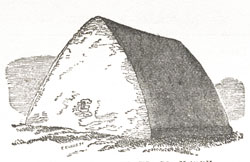Conn of the Hundred Battles

Oratory at Gallarus, County Kerry
Tuathal—Conn "of the Hundred Battles"—The Five Great Roads of Ancient Erinn—Conn's Half—Conairé II.—The Three Cairbrés—Cormac Mac Airt—His Wise Decision—Collects Laws—His Personal Appearance—The Saltair of Tara written in Cormac's Reign—Finn Mac Cumhaill—His Courtship with the Princess Ailbhé—The Pursuit of Diarmaid and Grainné—Nial "of the Nine Hostages"—Dathi.

UATHAL reigned for thirty years, and is said to have fought no less than 133 battles with the Attacotti. He was at last slain himself by his successor, Nial, who, in his turn, was killed by Tuathal's son. Conn "of the Hundred Battles" is the next Irish monarch who claims more than a passing notice. His exploits are a famous theme with the bards, and a poem on his " Birth" forms part of the Liber Flavus Fergusorum, a MS. volume of the fifteenth century. His reign is also remarkable for the mention of five great roads[2] which were then discovered or completed. One of these highways, the Eiscir Riada, extended from the declivity on which Dublin Castle now stands, to the peninsula of Marey, at the head of Galway Bay.
It divided Conn's half of Ireland from the half possessed by Eóghan Môr, with whom he lived in the usual state of internecine feud which characterized the reigns of this early period. One of the principal quarrels between these monarchs, was caused by a complaint which Eóghan made of the shipping arrangements in Dublin. Conn's half (the northern side) was preferred, and Eóghan demanded a fair division. They had to decide their claims" at the battle of Magh Lena.[3] Eóghan was assisted by a Spanish chief, whose sister he had married. But the Iberian and his Celtic brother-in-law were both slain, and the mounds are still shown which cover their remains.
Notes
[2] Roads.—Those roads were Slighe Asail, Slighe Midhluachra, Slighe Cua-lann, Slighe Dala, and Slighe Môr. Slighe Môr was the Eiscir Riada, and division line of Erinn into two parts, between Conn and Eóghan Môr. These five roads led to the fort of Teamair (Tara), and it is said that they were "discovered" on the birthnight of the former monarch. We shall refer to the subject again in a chapter on the civilization of the early Irish. There is no doubt of the existence of these roads, and this fact, combined with the care with which they were kept, is significant.
[3] Magh Lena.—The present parish of Moylana, or Kilbride, Tullamore, King's county.
